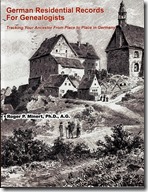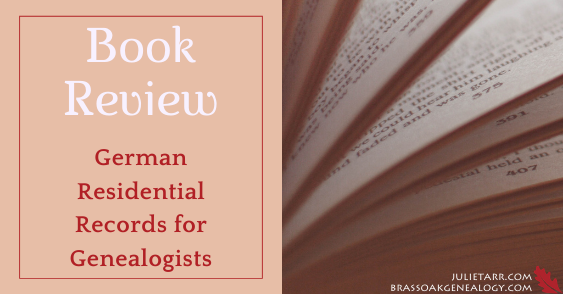 Title: German Residential Records for Genealogists
Title: German Residential Records for Genealogists
Author: Roger P. Minert, PhD
Format: Paperback
Published: 2018
The following review first appeared in the Federation of Genealogical Societies FORUM magazine (Fall 2019); reprinted with permission.
Roger Minert, PhD, AG, has published yet another helpful reference book for those seeking their German roots. In German Residential Records for Genealogists, Minert introduces readers to little-known records that can be a goldmine for researching German ancestors.
In the introduction, Minert presents a brief history of what are called residential records. These records basically record the movement of foreigners. This book focuses on the registration of foreigners in each German state in the nineteenth century, although records do exist in some locations much earlier. The registrations were governed by law, and changed over time. In some locations, the registrations were expanded to include all residents, not just foreigners. Typically, registration records of the nineteenth century include the newcomer’s name, occupation, birth place or previous residence, date of arrival, and date of departure.
There are 38 chapters, one for each state that became part of the German Empire in 1871. Each chapter, arranged alphabetically by the state’s German name, contains four sections: the state’s location, residential registration laws for the state, how to access the records, and selected images of records found within the state. Understanding the law for each location will help readers determine whether these records will be useful in their particular research situation. As for finding the records, in some cases they may be microfilmed and held by the Family History Library. In rare cases they may be digitized online. In most cases, however, readers will come to find that many of these records need to be sought out in the town/city archives. Minert provides tips for finding records in the Family History Library catalog, however, the tips pertain to the English-rendered catalog categories displayed for a location. While the introduction does contain some German terms in the discussion of the records, a list of common terminology used to title these records would have been helpful, especially for searching the FHL catalog and other places such as German archival inventories.
Because this books covers the 38 states that made up the German Empire until 1918, today’s researchers could be dealing with archives in Germany, France, and/or Poland. Minert provides a helpful appendix that deals with contacting archives in these three countries.
Minert, yet again, has provided an invaluable reference for those with German ancestors. Anyone who has German roots should pick up a copy of this book to learn more about residential records and how they can be used in genealogical research.

